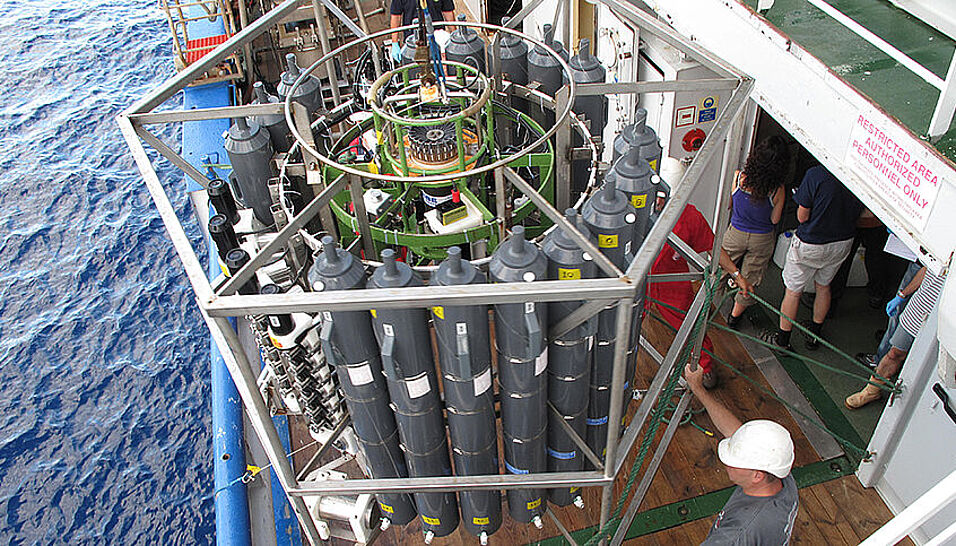An international team of marine biologists including Gerhard J. Herndl and Eva Sintes from the University of Vienna has developed a method to determine the respiration activity of individual bacterial species. Using this new tool, they found that in the open ocean less abundant bacterial species have the highest respiration rates, i.e. they consume more oxygen and produce more CO2. The species that are particularly abundant in the ocean, on the other hand, consume a relatively small amount of organic material. Less than 3% of the bacteria in the ocean thus consume one-third of all oxygen. These findings have major implications for our view on the ocean carbon cycle and currently appear in the prestigious journal Nature.
Frequent does not equal important
Hundreds of thousands of different species of bacteria can be found in a liter of ocean water. Just like us, most of these bacteria breathe oxygen to extract energy from organic material and produce carbon dioxide in the process. To estimate how high the respiratory activity of marine microbes is, researchers have previously divided the sum the total respiratory activity by the number of organisms present. However, this approach does not consider the overwhelming biodiversity of different marine bacteria, which do not all have the same respiratory activity.
The study, published in the journal Nature, now shows that some of the differences are serious: "The respiratory activity of individual bacterial species in seawater can vary up to a factor of a thousand. We have found that it is precisely those less abundant bacteria in the ocean that show the highest respiratory activities, while very abundant bacteria have low respiratory activities," explains Gerhard J. Herndl of the University of Vienna, one of the co-authors of the international study. This means that for the carbon cycle in the oceans, the rare bacteria are more important overall than the microorganisms that are found in large numbers in seawater. "This is a common misconception in ecology and in looking at biogeochemical cycles. It's not necessarily those groups of organisms or nutrients that are present in the highest concentrations that are most important, but very often those that are present only in low concentrations," Herndl explains.
New method combines measurement of respiratory activity with microbial DNA
To understand the complex community of microorganisms in the ocean, the international team developed a new method that allows them to link respiratory activity and the genetic code of individual cells. The researchers first used fluorescent probes to measure the respiration rates of individual bacterial cells; the more respiratory activity, the more fluorescence signal is emitted by the cell. This fluorescence signal is subsequently measured and the cells are sorted according to their fluorescence intensity. The individual cells are then subjected to genetic analysis to determine the species. Bacterial communities from the Gulf of Maine, the Mediterranean Sea, and the open Atlantic and Pacific Oceans were examined for the study.
Bacteria and the ocean carbon cycle
Bacteria, which convert organic material back into inorganic components such as CO2, dominate the carbon cycle in the ocean, converting more organic material than all the other living organisms in the ocean combined. Therefore, they play a major role in the oceanic carbon cycle and it is extremely important to measure their respiration as an activity parameter: "If most bacteria in the ocean are only mildly active, as our study shows, this means that a few bacterial species have very high material conversion rates. At the same time, however, these highly active bacteria are obviously heavily grazed, i.e. eaten by other creatures, so that they only occur in low abundances. High activity therefore also means high loss rates due to grazing. This in turn means that only a few species of bacteria ensure that we have a high carbon flux, while the majority of bacteria are rather inactive, grow slowly, and are also consumed to a low extend. These new findings have major implications for the study of global nutrient cycles such as the carbon cycle, since the ocean is responsible for a large part of the global carbon cycle," says Gerhard J. Herndl
Publication in "Nature":
"Decoupling of respiration rates and abundance in marine Prokaryoplankton": Jacob H. Munson-McGee, Melody R. Lindsay, Julia M. Brown, Eva Sintes, Timothy D’Angelo, Joe Brown, Laura C. Lubelczyk, Paxton Tomko, David Emerson, Beth N. Orcutt, Nicole J. Poulton, Gerhard J. Herndl, Ramunas Stepanauskas. Nature

